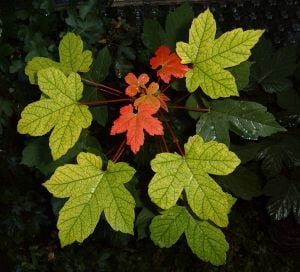Sycamore
Sycamore is a name which is applied at various times and places to three very different types of trees, but with somewhat similar leaf forms.
- The sycamore (or sycomore) of the Bible is a species of fig, Ficus sycomorus, the sycamore fig or fig-mulberry, native to the Middle East and eastern Africa. This tree was used in Ancient Egypt for medicine and mentioned in Egyptian mythology. [1]
- The sycamore of Britain and Ireland is a European maple tree, Acer pseudoplatanus, also called Sycamore Maple or confusingly the Plane tree in Scotland.
- The sycamores of North America are members of the genus Platanus. There are several species, including the American sycamore, and the California sycamore.
Ficus_sycomorus
| Fig-mulberry | ||||||||||||||||
|---|---|---|---|---|---|---|---|---|---|---|---|---|---|---|---|---|
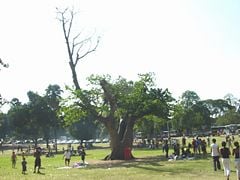 | ||||||||||||||||
| Scientific classification | ||||||||||||||||
| ||||||||||||||||
| Ficus sycomorus L. |
Ficus sycomorus, called the sycamore fig or the fig-mulberry (due to the leaves' resemblance to those of the Mulberry), sycamore, or sycomore, is a fig species that has been cultivated since early times. (Note that the name sycamore has been used for a variety of plants.) Ficus sycomorus is native to Africa south of the Sahel and north of the Tropic of Capricorn, also excluding the central-west rainforest areas. It also grows naturally in the southern Arabian Peninsula and in very localized areas in Madagascar, and has been naturalised in Israel and Egypt. In its native habitat, the tree is usually found in rich soils along rivers, but also in mixed woodlands.
Ficus sycomorus grows to 20 m tall and 6 m wide with a dense round crown of spreading branches. The leaves are heart-shaped with a round apex, 14 cm long by 10 cm wide, and arranged spirally around the twig. They are dark green above and lighter with prominent yellow veins below, and both surfaces are rough to the touch. The petiole is 0.5-3 cm long and pubescent. The fruit is a large edible fig, 2-3 cm in diameter, ripening from buff-green to yellow or red. They are borne in thick clusters on long branchlets or the leaf axil. Flowering and fruiting occurs year-round, peaking from July to December. The bark is green-yellow to orange and exfoliates in papery strips to reveal the yellow inner bark. Like all other figs, it contains a latex.
F. sycomorus is in the Near Orient a tree of great importance and very extensive use. It has wide-spreading branches and affords a delightful shade. The ancient Egyptians cultivated this species "almost exclusively", according to Zohary and Hopf. Remains of F. sycomorus begin to appear in predynastic levels, and in quantity from the start of the third millennium B.C.E. Zohary and Hopf note that "the fruit and the timber, and sometimes even the twigs, are richly represented in the tombs of Early, Middle and Late Kingdoms. in numerous cases the parched sycons bear characteristic gashing marks indicating that this art, which induces ripening, was practice in Egypt in ancient times."[1] Although this species of fig requires the presence of the symbiotic wasp Ceratosolen arabicus to reproduce sexually, and this insect is extinct in Egypt, Zohay and Hopf have no doubt that Egypt was "the principal area of sycamore fig development." Some of the caskets of mummies in Egypt are made from the wood of this tree.
In the Bible, Amos 7:14 refers to the fruit of the sycamore, which is of an inferior character; so also probably Jeremiah 24:2. At Jericho, Zacchaeus climbed a sycamore-tree to see Jesus as he passed by (Luke 19:4).
Acer pseudoplatanus
| Sycamore Maple | ||||||||||||||
|---|---|---|---|---|---|---|---|---|---|---|---|---|---|---|
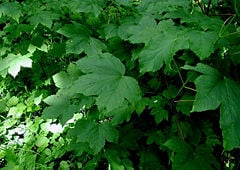 Sycamore Maple leaves
| ||||||||||||||
| Scientific classification | ||||||||||||||
| ||||||||||||||
| Acer pseudoplatanus L. |
Acer pseudoplatanus, commonly known as sycamore in many parts of Europe, sycamore maple in North America (to distinguish it from Platanus occidentalis, which is also called sycamore), and Plane in Scotland. It is one of the most common maples in Europe, native to central Europe from France east to Poland, and south in the mountains to northern Spain and Turkey. Sycamores now occur throughout the British Isles, having been introduced in the 17th century[2].
The sycamore is a deciduous tree that reaches 20–35 m tall at maturity, with a broad, domed crown. On young trees, the bark is smooth and grey but becomes rougher with age and breaks up in scales, exposing the pale-brown-to-pinkish inner bark.
The leaves are opposite, 10-25 cm long and broad with a 5-15 cm petiole, palmately-veined with five lobes with toothed edges, and dark green in colour; some cultivars have purple-tinged or yellowish leaves.
The monoecious yellow-green flowers are produced in spring on 10-20 cm pendulous racemes, with 20-50 flowers on each stalk. The 5-10 mm diameter seeds are paired in samaras, each seed with a 20-40 mm long wing to catch the wind and rotate when they fall; this helps them to spread further from the parent tree. The seeds are mature in autumn about 6 months after pollination.
The name "sycamore" originally belongs to the fig species Ficus sycomorus native to southwest Asia (this is the sycamore or sycomore referred to in the Bible), and was later misapplied to this species (and others; see also Platanus) by reason of the superficial similarity in leaf shape. To avoid confusion, the name Sycamore Maple is used here.
The Sycamore Maple is noted for its tolerance of wind, urban pollution and salt spray, which makes it a popular tree for planting in cities, along roads treated with salt in winter, and in coastal localities. It is cultivated and widely naturalised north of its native range in northern Europe, notably in the British Isles and Scandinavia north to Tromsø, Norway; Reykjavík, Iceland, and Torshavn on the Faroe Islands. In North America, escapes from cultivation are most common in New England, New York City and the Pacific Northwest. It is planted in many temperate parts of the Southern Hemisphere, most commonly in New Zealand and on the Falkland Islands. The popular cultivar 'Brilliantissimum' is notable for the bright salmon-pink colour of the young foliage.
Sycamore is planted for timber production; the wood is white with a silky lustre, and hard-wearing, used for furniture and flooring. Occasional trees produce wood with a wavy grain, greatly increasing the value for decorative veneers. European sycamore is a traditional wood used in creating necks, backs, and scrolls for violins.
Sycamore flowers produce abundant nectar, which makes a fragrant, delicately flavoured and pale-coloured honey.
Stages in opening leaf buds.
Platanus genus
| Platanus | ||||||||||||
|---|---|---|---|---|---|---|---|---|---|---|---|---|
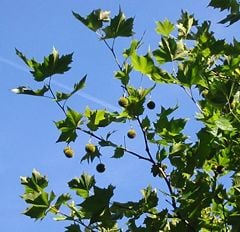 Leaves and fruit of a London Plane
| ||||||||||||
| Scientific classification | ||||||||||||
| ||||||||||||
|
See text |
- "Plane tree" redirects here. In mathematics, "plane tree" refers to a tree embedded in the plane.
The genus Platanus is a small genus of trees native to the Northern Hemisphere. They are the sole members of the family Platanaceae.
They are all large trees to 30–50 m tall, deciduous (except for P. kerrii), and are mostly found in riparian or other wetland habitats in the wild, though proving drought tolerant in cultivation away from streams.
They are known as planes in Europe, and as sycamores in North America. (Outside North America, the name "sycamore" refers to either the fig Ficus sycomorus, the plant originally so named, or the Great Maple, Acer pseudoplatanus.)
Natural history
The flowers are reduced and are borne in balls (globose head); 3–7 hairy sepals may be fused at base, and the petals are 3–7 (or no) and spathulate. Male and female flowers are separate, but on the same plant (monoecious). The number of heads in one cluster (inflorescence) is indicative of the species (see table below). The male flower has with 3–8 stamens; the female has a superior ovary with 3–7 carpels. Plane trees are wind-pollinated. Male balls fall off the branch after shedding their pollen. The female flowers, on the other hand, remain attached to the branch firmly.
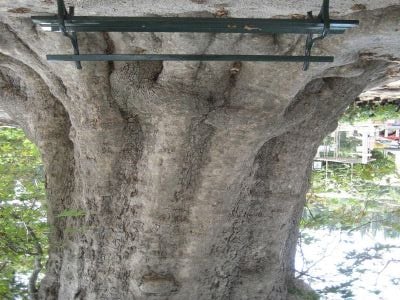
After being pollinated, the female flowers become achenes that aggregate on the ball. Typically, the core of the ball is 1 cm in diameter and is covered with a net of mesh 1 mm, which can be peeled off. The ball is 2.5–4 cm in diameter and contains several hundred achenes, each of which has a single seed and is conical, with the point attached downward to the net at the surface of the ball. There is also a tuft of many thin stiff yellow-green bristle fibers attached to the base of each achene. These bristles help in wind dispersion of the fruits like dandelion.
The mature bark peels (exfoliates) off easily in irregularly shaped patches, producing a mottled, scaly appearance. Very old bark may not flake off, but can crack instead. The base of the leaf stalk (petiole) is enlarged and completely wraps around the young stem bud in its axil. The bud will be exposed only after the leaf falls off.
Phylogeny
There are two subgenera, subgenus Castaneophyllum containing the anomalous P. kerrii, and subgenus Platanus, with all the others; recent studies in Mexico[3] have increased the number of accepted species in this subgenus. Within subgenus Platanus, genetic evidence suggests that P. racemosa is more closely related to P. orientalis than it is to the other North American species.[4] There are fossil records of plane trees as early as 115 million years (the Lower Cretaceous). Despite the geographic separation between North America and Europe, species from these continents will cross readily resulting in fertile hybrids such as the London Plane.
Species
The following are recognized species of plane trees:
| Scientific name | Common name | Distribution | flowerheads | Notes |
|---|---|---|---|---|
| Platanus chiapensis | Chiapas Plane | southeast Mexico | ? | Subgenus Platanus |
| Platanus gentryi | Gentry's Plane | western Mexico | ? | Subgenus Platanus |
| Platanus × hispanica (P. occidentalis × P. orientalis; syn. P. × acerifolia) |
London Plane | Cultivated origin | 1-6 | Subgenus Platanus |
| Platanus kerrii | Kerr's Plane | Laos, Vietnam | 10-12 | Subgenus Castaneophyllum |
| Platanus mexicana | Mexican Plane | northeast and central Mexico | 2-4 | Subgenus Platanus |
| Platanus oaxacana | Oaxaca Plane | southern Mexico | ? | Subgenus Platanus |
| Platanus occidentalis | American Sycamore, American Plane or Buttonwood | eastern North America | 1-2 | Subgenus Platanus |
| Platanus orientalis | Oriental Plane | southeast Europe, southwest Asia | 3-6 | Subgenus Platanus |
| Platanus racemosa | California Sycamore | California | 3-7 | Subgenus Platanus |
| Platanus rzedowskii | Rzedowski's Plane | eastern Mexico | ? | Subgenus Platanus |
| Platanus wrightii | Arizona Sycamore | Arizona, New Mexico, northwest Mexico | 2-4 | Subgenus Platanus |
Notes
ReferencesISBN links support NWE through referral fees
- Feng, Y.; Oh, S.-H., & Manos, P. S. (2005). Phylogeny and Historical Biogeography of the Genus Platanus as Inferred From Nuclear and Chloroplast DNA. Syst. Bot. 30 (4): 786-799 abstract
- Nixon, K. C. & Poole, J. M. (2003). Revision of the Mexican and Guatemalan species of Platanus (Platanaceae). Lundellia 6: 103-137 abstract.
References
- Humphries C.J., Press J.R. and Sutton D.A. : Trees of Britain and Europe (Hamlyn guide); The Hamlyn Publishing Group Ltd., 1992; ISBN 0-600-57511-X
- Hessayon Dr. D.G. The Tree & Shrub Expert, ISBN 0-903505-17-7
Notes
External links
- Figweb.org
- U-landslære Approaches to Development - Sycamore Fig
- Botswana Tourism Flora and Fauna
- PBS Nature documentary "The Queen of Trees" (on the sycamore fig in Kenya)
External links
- Botany of Plane trees
- Flora of North America: Platanus
- Photos with descriptions
- A developmental and evolutionary analysis of embryology in Platanus (platanaceae), abasal eudicot, abstract of article by Sandra K. Floyd et al. in American Journal of Botany, 1999;86:1523-1537.
Credits
New World Encyclopedia writers and editors rewrote and completed the Wikipedia article in accordance with New World Encyclopedia standards. This article abides by terms of the Creative Commons CC-by-sa 3.0 License (CC-by-sa), which may be used and disseminated with proper attribution. Credit is due under the terms of this license that can reference both the New World Encyclopedia contributors and the selfless volunteer contributors of the Wikimedia Foundation. To cite this article click here for a list of acceptable citing formats.The history of earlier contributions by wikipedians is accessible to researchers here:
The history of this article since it was imported to New World Encyclopedia:
Note: Some restrictions may apply to use of individual images which are separately licensed.
